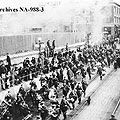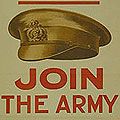|
World War I and Aftermath
 When the First World War was declared, Alberta found itself giving more than
it expected, having 48,885 men enlist. On a per capita
basis, Alberta was providing more than any other province. The war years brought
stories of Albertan's valour, heroism, and loss. Of those who enlisted, it
is estimated 6,140 were killed and about 20,000 wounded. Many communities across
Alberta felt the loss of these men. When the First World War was declared, Alberta found itself giving more than
it expected, having 48,885 men enlist. On a per capita
basis, Alberta was providing more than any other province. The war years brought
stories of Albertan's valour, heroism, and loss. Of those who enlisted, it
is estimated 6,140 were killed and about 20,000 wounded. Many communities across
Alberta felt the loss of these men.

The war years were also difficult for Alberta's immigrants.
German immigrants, who had earned reputations of being hard workers and good neighbours,
were now viewed as the enemy. Ukrainian and Italian immigrants were suspected of being loyal to the Austro-Hungarian empire
or promoters of fascism. Many were placed in internment camps around Alberta. It took decades for the wounds of the war years to be healed.
 Adding to the uncertainty and change the war had brought was the Spanish Flu
that arrived in Alberta on 7 October 1918 when 15 soldiers were diagnosed
with the disease. Families were devastated and children orphaned as 3,259
Albertans died in less than six months. Adding to the uncertainty and change the war had brought was the Spanish Flu
that arrived in Alberta on 7 October 1918 when 15 soldiers were diagnosed
with the disease. Families were devastated and children orphaned as 3,259
Albertans died in less than six months.
With the end of the First World War, Canada entered an era of uncertainty.
The Russian
Revolution of 1917 had created a great amount of apprehension regarding the rise
of socialism, and the anti-foreigner sentiment that surfaced in Canada during the
war continued to intensify with postwar economic instability. Spurred on by
social unrest, in 1919 the
Canadian government revised the Immigration Act.
Although the Immigration Act of 1910 provided the federal government with the
power to limit immigration as it saw fit, the revisions of 1919 formalized
immigration guidelines based on preferred cultural and ideological traits.
A new rule allowed the government to prohibit the entry of "undesirable" races
and nationalities.
The aftermath of the war left
Alberta, like much of the world, on shaky economic and
social footing. The 1920s and 30s were marked by
political change, labour strikes, and the Great
Depression. Meanwhile, across the Atlantic, the stage
was being set for the Second World War.
|  Heritage Community Foundation Presents
Heritage Community Foundation Presents
 Heritage Community Foundation Presents
Heritage Community Foundation Presents